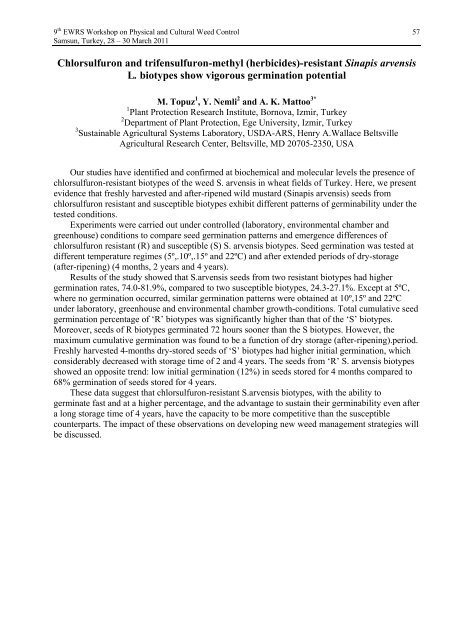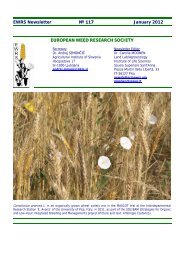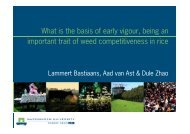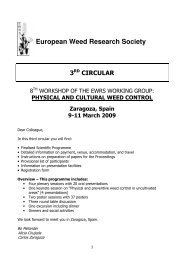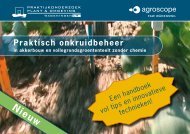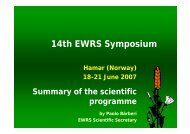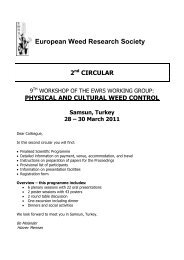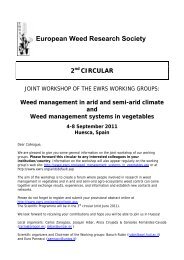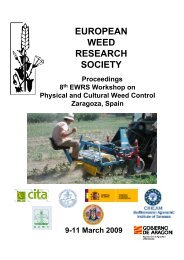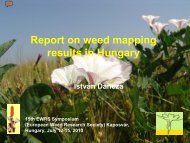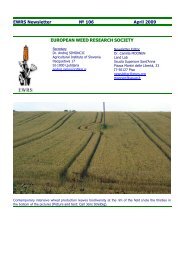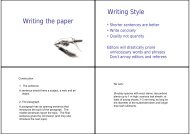Physical and Cultural Weed Control Working Group of - European ...
Physical and Cultural Weed Control Working Group of - European ...
Physical and Cultural Weed Control Working Group of - European ...
You also want an ePaper? Increase the reach of your titles
YUMPU automatically turns print PDFs into web optimized ePapers that Google loves.
9 th EWRS Workshop on <strong>Physical</strong> <strong>and</strong> <strong>Cultural</strong> <strong>Weed</strong> <strong>Control</strong> 57<br />
Samsun, Turkey, 28 – 30 March 2011<br />
Chlorsulfuron <strong>and</strong> trifensulfuron-methyl (herbicides)-resistant Sinapis arvensis<br />
L. biotypes show vigorous germination potential<br />
M. Topuz 1 , Y. Nemli 2 <strong>and</strong> A. K. Mattoo 3*<br />
1 Plant Protection Research Institute, Bornova, Izmir, Turkey<br />
2 Department <strong>of</strong> Plant Protection, Ege University, Izmir, Turkey<br />
3 Sustainable Agricultural Systems Laboratory, USDA-ARS, Henry A.Wallace Beltsville<br />
Agricultural Research Center, Beltsville, MD 20705-2350, USA<br />
Our studies have identified <strong>and</strong> confirmed at biochemical <strong>and</strong> molecular levels the presence <strong>of</strong><br />
chlorsulfuron-resistant biotypes <strong>of</strong> the weed S. arvensis in wheat fields <strong>of</strong> Turkey. Here, we present<br />
evidence that freshly harvested <strong>and</strong> after-ripened wild mustard (Sinapis arvensis) seeds from<br />
chlorsulfuron resistant <strong>and</strong> susceptible biotypes exhibit different patterns <strong>of</strong> germinability under the<br />
tested conditions.<br />
Experiments were carried out under controlled (laboratory, environmental chamber <strong>and</strong><br />
greenhouse) conditions to compare seed germination patterns <strong>and</strong> emergence differences <strong>of</strong><br />
chlorsulfuron resistant (R) <strong>and</strong> susceptible (S) S. arvensis biotypes. Seed germination was tested at<br />
different temperature regimes (5º,.10º,.15º <strong>and</strong> 22ºC) <strong>and</strong> after extended periods <strong>of</strong> dry-storage<br />
(after-ripening) (4 months, 2 years <strong>and</strong> 4 years).<br />
Results <strong>of</strong> the study showed that S.arvensis seeds from two resistant biotypes had higher<br />
germination rates, 74.0-81.9%, compared to two susceptible biotypes, 24.3-27.1%. Except at 5ºC,<br />
where no germination occurred, similar germination patterns were obtained at 10º,15º <strong>and</strong> 22ºC<br />
under laboratory, greenhouse <strong>and</strong> environmental chamber growth-conditions. Total cumulative seed<br />
germination percentage <strong>of</strong> ‘R’ biotypes was significantly higher than that <strong>of</strong> the ‘S’ biotypes.<br />
Moreover, seeds <strong>of</strong> R biotypes germinated 72 hours sooner than the S biotypes. However, the<br />
maximum cumulative germination was found to be a function <strong>of</strong> dry storage (after-ripening).period.<br />
Freshly harvested 4-months dry-stored seeds <strong>of</strong> ‘S’ biotypes had higher initial germination, which<br />
considerably decreased with storage time <strong>of</strong> 2 <strong>and</strong> 4 years. The seeds from ‘R’ S. arvensis biotypes<br />
showed an opposite trend: low initial germination (12%) in seeds stored for 4 months compared to<br />
68% germination <strong>of</strong> seeds stored for 4 years.<br />
These data suggest that chlorsulfuron-resistant S.arvensis biotypes, with the ability to<br />
germinate fast <strong>and</strong> at a higher percentage, <strong>and</strong> the advantage to sustain their germinability even after<br />
a long storage time <strong>of</strong> 4 years, have the capacity to be more competitive than the susceptible<br />
counterparts. The impact <strong>of</strong> these observations on developing new weed management strategies will<br />
be discussed.


